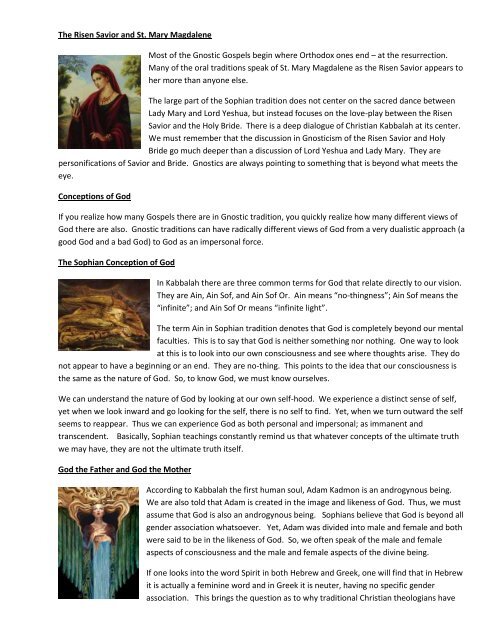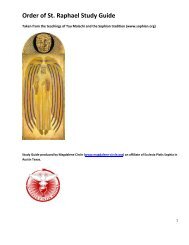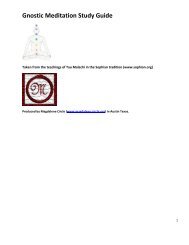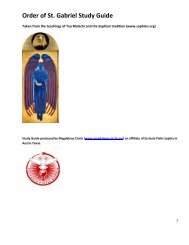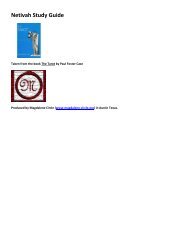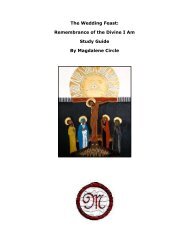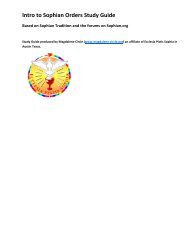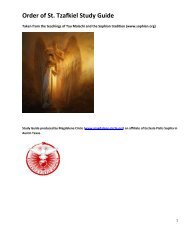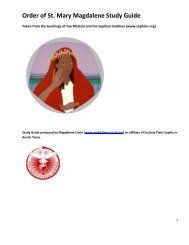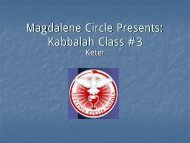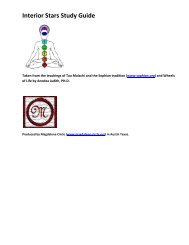Introduction to Sophian Gnosticism Study Guide - Magdalene Circle
Introduction to Sophian Gnosticism Study Guide - Magdalene Circle
Introduction to Sophian Gnosticism Study Guide - Magdalene Circle
- No tags were found...
Create successful ePaper yourself
Turn your PDF publications into a flip-book with our unique Google optimized e-Paper software.
The Risen Savior and St. Mary <strong>Magdalene</strong>Most of the Gnostic Gospels begin where Orthodox ones end – at the resurrection.Many of the oral traditions speak of St. Mary <strong>Magdalene</strong> as the Risen Savior appears <strong>to</strong>her more than anyone else.The large part of the <strong>Sophian</strong> tradition does not center on the sacred dance betweenLady Mary and Lord Yeshua, but instead focuses on the love-play between the RisenSavior and the Holy Bride. There is a deep dialogue of Christian Kabbalah at its center.We must remember that the discussion in <strong>Gnosticism</strong> of the Risen Savior and HolyBride go much deeper than a discussion of Lord Yeshua and Lady Mary. They arepersonifications of Savior and Bride. Gnostics are always pointing <strong>to</strong> something that is beyond what meets theeye.Conceptions of GodIf you realize how many Gospels there are in Gnostic tradition, you quickly realize how many different views ofGod there are also. Gnostic traditions can have radically different views of God from a very dualistic approach (agood God and a bad God) <strong>to</strong> God as an impersonal force.The <strong>Sophian</strong> Conception of GodIn Kabbalah there are three common terms for God that relate directly <strong>to</strong> our vision.They are Ain, Ain Sof, and Ain Sof Or. Ain means “no-thingness”; Ain Sof means the“infinite”; and Ain Sof Or means “infinite light”.The term Ain in <strong>Sophian</strong> tradition denotes that God is completely beyond our mentalfaculties. This is <strong>to</strong> say that God is neither something nor nothing. One way <strong>to</strong> lookat this is <strong>to</strong> look in<strong>to</strong> our own consciousness and see where thoughts arise. They donot appear <strong>to</strong> have a beginning or an end. They are no-thing. This points <strong>to</strong> the idea that our consciousness isthe same as the nature of God. So, <strong>to</strong> know God, we must know ourselves.We can understand the nature of God by looking at our own self-hood. We experience a distinct sense of self,yet when we look inward and go looking for the self, there is no self <strong>to</strong> find. Yet, when we turn outward the selfseems <strong>to</strong> reappear. Thus we can experience God as both personal and impersonal; as immanent andtranscendent. Basically, <strong>Sophian</strong> teachings constantly remind us that whatever concepts of the ultimate truthwe may have, they are not the ultimate truth itself.God the Father and God the MotherAccording <strong>to</strong> Kabbalah the first human soul, Adam Kadmon is an androgynous being.We are also <strong>to</strong>ld that Adam is created in the image and likeness of God. Thus, we mustassume that God is also an androgynous being. <strong>Sophian</strong>s believe that God is beyond allgender association whatsoever. Yet, Adam was divided in<strong>to</strong> male and female and bothwere said <strong>to</strong> be in the likeness of God. So, we often speak of the male and femaleaspects of consciousness and the male and female aspects of the divine being.If one looks in<strong>to</strong> the word Spirit in both Hebrew and Greek, one will find that in Hebrewit is actually a feminine word and in Greek it is neuter, having no specific genderassociation. This brings the question as <strong>to</strong> why traditional Christian theologians have


